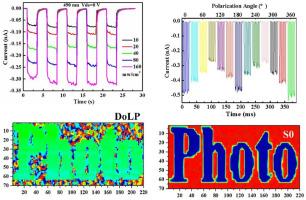High performance self-driven broadband photodetector for polarized imaging based on novel ZrS3/ReSe2 van der Waals heterojunction
IF 8.2
2区 材料科学
Q1 MATERIALS SCIENCE, MULTIDISCIPLINARY
引用次数: 0
Abstract
The distinctive characteristics of anisotropic two-dimensional (2D) materials, including in-plane anisotropy of optical absorption and carrier mobility, render them exceptionally suitable for application in the field of polarization detection and as a novel platform for the polarization imaging. Meanwhile, the consolidation of diverse functionalities within a single photodetector is highly anticipated to meet the demands of some special scenarios. Herein, a novel ZrS3/ReSe2 van der Waals (vdWs) heterostructure device was successfully constructed to realize polarization-sensitive, self-powered, and broadband photodetection and imaging. Owing to the built-in electric field of the type-II band alignment within the heterojunction, the device achieves a self-powered photoresponse ranging from 300 to 980 nm, an ultralow dark currentt ∼1 pA, and a commendable rise/decay time of 0.35/0.28 ms. Additionally, it has been demonstrated that the self-driven photodetector possesses a polarization-sensitivity with a notable anisotropic ratio about 2.02 (1.98) under 490 nm (980 nm) light illumination with zero bias, coupled with an excellent repeatability and stability. Furthermore, we also demonstrate the polarization imaging capabilities of the device in visible and near-infrared spectrum, realizing a contrast-enhanced degree of linear polarization imaging. This work paves a new platform to develop heterojunction photodetectors for high performance polarization-sensitive photodetection and next-generation polarized imaging.

基于新型 ZrS3/ReSe2 范德华异质结的高性能自驱动偏振成像宽带光电探测器
各向异性二维(2D)材料的独特特性,包括光学吸收和载流子迁移率的面内各向异性,使其特别适合应用于偏振检测领域,并成为偏振成像的新型平台。同时,在单个光电探测器中整合多种功能以满足一些特殊应用场景的需求也备受期待。在此,我们成功构建了一种新型 ZrS3/ReSe2 范德瓦耳斯(vdWs)异质结构器件,以实现偏振敏感、自供电和宽带光电探测与成像。由于异质结内 II 型带排列的内置电场,该器件实现了从 300 纳米到 980 纳米的自供电光响应、超低暗电流 t ∼ 1 pA 以及值得称赞的 0.35/0.28 毫秒上升/衰减时间。此外,我们还证明了自驱动光电探测器具有偏振灵敏度,在 490 nm(980 nm)光照和零偏压条件下,各向异性比约为 2.02(1.98),同时具有出色的重复性和稳定性。此外,我们还展示了该装置在可见光和近红外光谱下的偏振成像能力,实现了对比度增强的线性偏振成像。这项工作为开发用于高性能偏振敏感光探测和下一代偏振成像的异质结光电探测器铺平了新的平台。
本文章由计算机程序翻译,如有差异,请以英文原文为准。
求助全文
约1分钟内获得全文
求助全文
来源期刊

Materials Today Nano
Multiple-
CiteScore
11.30
自引率
3.90%
发文量
130
审稿时长
31 days
期刊介绍:
Materials Today Nano is a multidisciplinary journal dedicated to nanoscience and nanotechnology. The journal aims to showcase the latest advances in nanoscience and provide a platform for discussing new concepts and applications. With rigorous peer review, rapid decisions, and high visibility, Materials Today Nano offers authors the opportunity to publish comprehensive articles, short communications, and reviews on a wide range of topics in nanoscience. The editors welcome comprehensive articles, short communications and reviews on topics including but not limited to:
Nanoscale synthesis and assembly
Nanoscale characterization
Nanoscale fabrication
Nanoelectronics and molecular electronics
Nanomedicine
Nanomechanics
Nanosensors
Nanophotonics
Nanocomposites
 求助内容:
求助内容: 应助结果提醒方式:
应助结果提醒方式:


